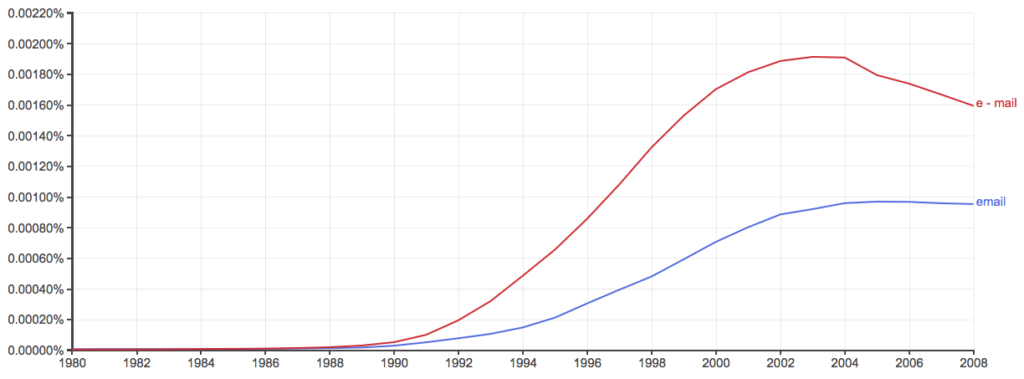In the digital age, communication can be instantaneous. We don’t need to wait three days for a bank statement or a letter from a friend. Electronic messaging has changed the way humans interact with one another, for better and for worse.
The most common form of digital communication is e-mail. Writers spell this word several different ways, including email, Email, and E-mail. Continue reading for an explanation of this term.
What is the Difference Between E-mail and Email?
In this post, I will compare e-mail vs. email. I will use each of these words in at least one example sentence, so that you can see them in context.
Plus, I will show you a helpful memory tool that you can use as reminder of whether to choose email or e-mail.
When to use E-mail
 What does e-mail mean? E-mail can be a noun or a verb.
What does e-mail mean? E-mail can be a noun or a verb.
As a noun, it is a shortened form of electronic mail, and it describes digital messages sent electronically. There are many types of digital messaging services. E-mail was invented in the second half of the 20th century and predates the Internet.
E-mail has replaced paper mail for a wide variety of correspondence, and is the preferred method of communication in many workplaces.
Here are some examples,
- “Greg, please complete the monthly audit and send me an e-mail me when you have finished,” said Sandy.
- Algernon drafted an e-mail to his coworker, but did not send it.
As a verb, e-mail means to send an electronic message.
See the examples below,
- I e-mailed my professor my essay, but she never responded.
- “You can just e-mail it to me,” said Jenny, hoping that Bob would stop talking to her about the supply spreadsheet.
E-mail can be conjugated the following ways
- First person present: I/we e-mail
- Second person present: You e-mail
- Third person singular present: He/she e-mails
- Third person plural present: They e-mail
- Simple past: E-mailed
- Present participle: E-mailing
When to Use Email
 What does email mean? Email is a variant spelling of e-mail. Neither spelling is incorrect, and both are widely accepted.
What does email mean? Email is a variant spelling of e-mail. Neither spelling is incorrect, and both are widely accepted.
Some sources recommend that e-mail and email be capitalized, like E-mail and Email. This convention, however, is dying out.
The chart below shows the relative usage of email vs. e-mail in English books since 1980. As you can see, the terms have a relatively short usage history, seeing their first widespread use in the 1990s.

The hyphenated e-mail is more common than the unhyphenated email. The graph, which only graphs books, shows the two appearing a rate of approximately 1.7:1.
E-mail or Email: Which to Choose?
 Since this is a newly minted term, there isn’t a single standard form. When it was initially coined, the standout spelling was e-mail, and, indeed, this spelling is still the predominate spelling today.
Since this is a newly minted term, there isn’t a single standard form. When it was initially coined, the standout spelling was e-mail, and, indeed, this spelling is still the predominate spelling today.
That said, The AP Stylebook states that email is acceptable for all references to electronic mail, so, as I mentioned earlier, both spellings are acceptable. Only time will tell what spelling wins out in the end: although, it is likely to be the unhyphenated email.
It should also be noted that while email has become an accepted spelling, this doesn’t work for every single thing that a technology company puts an e in front of.
For example,
- e-book
- e-business
- e-commerce
The AP Stylebook lists all of these spellings as the preferred spellings. In other words, e-mail is such a popular term that people are now accepting it without the hyphen. Other terms, which are more niche, are not there yet—and they may never be.
So, for the time being,
- e-mail or email (both accepted)
- e-book not ebook
- e-business not ebusiness
- e-commerce not ecommerce
Summary
Is it email or e-mail? E-mail is a form of electronic messaging. It is also spelled email, though e-mail is more common.
To conclude, default to e-mail unless instructed otherwise.
Contents
